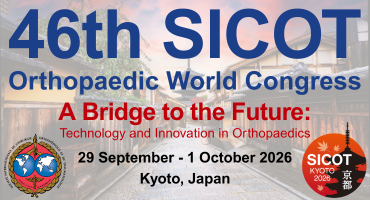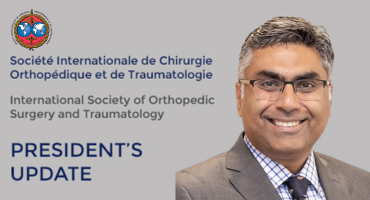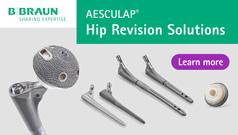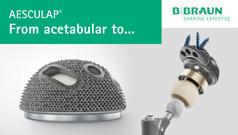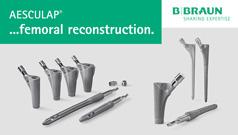
Exam Corner
Basic Science & Anatomy
SICOT Associate Member & SICOT Newsletter Associate Editor – London, United Kingdom
Questions
All of the below have an autosomal dominant inheritance pattern except:
Haemophilia
Osteochondromatosis
Ehlers Danlos syndrome
Kniest dysplasia
Metaphyseal epiphyseal dysplasia
The inheritance pattern for all of the following is correct except:
Hypophosphatemic rickets: X-linked dominant
Hunter syndrome: X-linked recessive
McCune Albright syndrome: Sporadic mutation
Marfan syndrome: Autosomal recessive
Hypophosphatasia: Autosomal recessive
The associated gene for all of the following is correct except:
Apert syndrome: FGF2R
McCune Albright syndrome: Gs alpha subunit of the receptor/adenylyl cyclase-coupling G proteins
Ehlers Danlos syndrome: COL 1A2 and COL 3A1
Synovial sarcoma: (X;19) (p11;q11)
Kniest dysplasia: COL 2A1
Accumulation of sphingomyelin in reticuloendothelial system cells occurs in which of the following?
Hunter syndrome
Hurler syndrome
Morquio syndrome
Gaucher disease
Niemann-Pick disease
Which of the following micro-organisms is associated with osteomyelitis in HIV patients?
Streptococcus viridans
Bacteroides species
Serratia marcescens
Eikenella species
Corynebacterium species
Which of the following growth plate zones is affected in Osteopetrosis?
Reserve zone
Proliferative zone
Hypertrophic zone
Primary spongiosa
Secondary spongiosa
Which of the following growth plate zones is affected in Osteogenesis imperfecta?
Reserve zone
Proliferative zone
Hypertrophic zone
Primary spongiosa zone
Secondary spongiosa zone
Which of the following does not occur in osteoarthritis?
Increased water content
Increased chondroitin levels
Increased keratin sulfate levels
Articular cartilage degradation
Genetic predisposition
Which of the following antibiotics inhibit cross-linking of polysaccharides in the cell wall by blocking transpeptidase enzyme?
B-lactam antibiotics
Aminoglycosides
Macrolides
Quinolones
Clindamycin
Which of the following intervals is bordered by teres minor superiorly and contains the axillary nerve?
Medial triangular space
Triangular interval
Quadrangular space
Lateral triangular space
None of the above
Which of the following nerve injuries is associated with medial winging of the scapula?
Suprascapular nerve
Spinal accessory nerve
Long thoracic nerve
Dorsal scapular nerve
Axillary nerve
The clavicle fuses at the age of:
5 weeks
12 weeks
1 year
5 years
25 years
The Thompson’s approach utilises the interval between which of the following?
Extensor carpi radialis brevis and extensor carpi radialis longus
Extensor carpi radialis brevis and anconeus
Extensor and flexor carpi ulnaris
Extensor carpi radialis brevis and extensor digitorum
Brachioradialis and flexor carpi radialis
Matti’s approach utilizes the interval between which of the following?
First and second extensor compartments
First and third extensor compartments
Second and third extensor compartments
Second and fourth extensor compartments
Third and fourth extensor compartments
Which of the following is related to an abnormality in osteoclasts function?
Vitamin-D deficiency rickets
Vitamin-D dependent rickets
Hypophosphatasia
Paget’s disease
Renal osteodystrophy
Which of the following is associated with reduced alkaline phosphatase levels?
Vitamin-D deficiency rickets
Vitamin-D dependent rickets
Hypophosphatasia
Paget’s disease
Renal osteodystrophy
Which of the following disorders is an osteochondrosis affecting the ischiopubic region?
Van Neck’s disease
Scheuermann’s disease
Panner’s disease
Kocher’s disease
Thiemann’s disease
Which of the following disorders is an osteochondrosis affecting the phalanges of the hand?
Van Neck’s disease
Scheuermann’s disease
Panner’s disease
Kocher’s disease
Thiemann’s disease
Which of the following disorders is an osteochondrosis affecting the capitellum?
Van Neck’s disease
Scheuermann’s disease
Panner’s disease
Kocher’s disease
Thiemann’s disease
Which of the following collagen types is usually seen in hypertrophic cartilage?
Type I
Type III
Type IV
Type X
Type XI
Answers
a
Haemophilia follows an X-linked recessive inheritance pattern.
Reference: Review of Orthopaedics, Millerd
Marfan syndrome follows an autosomal dominant inheritance pattern.
Reference: Review of Orthopaedics, Millerd
Synovial sarcoma: Associated gene includes (X;18) (p11;q11)£
Reference: Review of Orthopaedics, Millere
Accumulation of sphingomyelin in reticuloendothelial system cells occurs in Niemann-Pick disease which follows an autosomal recessive inheritance pattern.
Reference: Review of Orthopaedics, Millerc
Serratia marcescens is associated with osteomyelitis in IV drug abusers.
Reference: Review of Orthopaedics, Millere
The secondary spongiosa zone is affected in Osteopetrosis and the defect is related to CLCN7 gene.
Reference: Review of Orthopaedics, Millere
The secondary spongiosa zone is affected in Osteogenesis imperfecta and the defect is related to COL 1A1 and COL1A2 genes.
Reference: Review of Orthopaedics, Millerc
Reduced keratin sulfate levels is seen in osteoarthritis. All other options are related to osteoarthritis.
Reference: Review of Orthopaedics, Millera
B-lactams inhibit cross-linking of polysaccharides in the cell wall by blocking transpeptidase enzyme.
Aminoglycosides inhibit protein synthesis through binding to cytoplasmic 30S-ribosomal subunit.
Clindamycin and macrolides inhibit the dissociation of peptidyl-transfer RNA from ribosomes during translocation by binding to 50S-ribosomal subunit.
Quinolones inhibit DNA gyrase.
Reference: Review of Orthopaedics, Millerc
The quadrangular space is bordered by teres minor superiorly, teres major inferiorly, long head of triceps medially and humerus laterally. It transmits the axillary nerve and posterior circumflex humeral artery. The triangular interval also known as lateral triangular space contains the profunda brachii artery and radial nerve. The triangular space also known as medial triangular space transmits the circumflex scapular artery.
Reference: Surgical Exposures in Orthopaedics, Hoppenfeldc
Long thoracic nerve supplies serratus anterior and is associated with medial winging of the scapula when injured. Spinal accessory nerve supplies trapezius and is associated with lateral winging of the scapula when injured. Dorsal scapular nerve injury is associated with rhomboideus palsy. Osseous origins for winging include osteochondromas and fractures malunion.
Reference: Review of Orthopaedics, Millere
The clavicle is the first bone to appear at 5 weeks (fetal) and last to fuse at 25 years of age.
Reference: Review of Orthopaedics, Millerd
The Thompson’s approach utilises the interval between extensor carpi radialis brevis (radial nerve) and extensor digitorum and extensor pollicus longus (PIN).
Reference: Surgical Exposures in Orthopaedics, Hoppenfeldb
Matti’s approach utilizes the interval between first and third extensor compartments both innervated by PIN.
Reference: Review of Orthopaedics, Millerd
Paget’s disease is caused by osteoclastic abnormality with increased bone turnover. Clinical findings include deformities, pain, congestive heart failure and fractures. Radiographic findings include coarse trabeculae and ‘picture frame vertebrae’.
Reference: Review of Orthopaedics, Millerc
Hypophosphatasia is caused by a reduced alkaline phosphatase level. Clinical findings include bone deformities and hypotonia. Radiographic findings include poor mineralization.
Reference: Review of Orthopaedics, Millera
Van Neck’s disease is an ischiopubic synchondrosis.
Reference: Review of Orthopaedics, Millere
Thiemann’s disease is an osteochondrosis affecting the phalanges of the hand.
Reference: Review of Orthopaedics, Millerc
Panner’s disease is an osteochondrosis affecting the capitellum.
Reference: Review of Orthopaedics, Millerd
Type X collagen is associated with calcification of cartilage and is usually seen in hypertrophic cartilage.
Reference: Review of Orthopaedics, Miller






